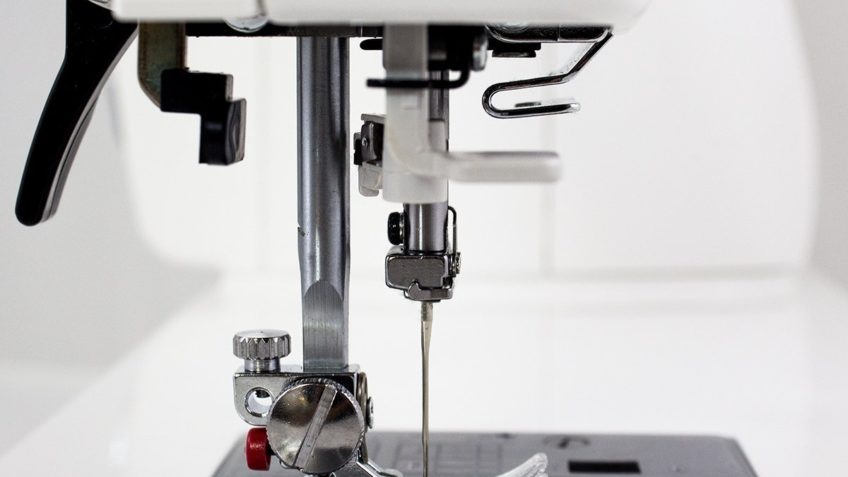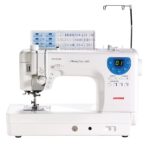I’ve used this machine several times a week during the past six months, and in that time I’ve seen nothing but consistent, pretty stitches. While the size and weight of this machine mean that this isn’t the model that you ‘d pack up to take to a friend’s house or a sewing class, it does mean that it’s a pretty heavy duty machine. Most of the time, I prefer just to cut the threads myself using the thread cutting blade at the back of the machine.
The speed control is like a governor for your sewing machine; it sets the maximum speed that your machine can go. Specifically, I would have liked to have seen more context about when or why to use special functions of the machine.
Way back in January, the folks at Janome sent me one of their sewing machines (on loan) to review and use. I’ve spent six months sewing on the Janome Memory Craft 6300, learning the ins and outs of this machine and becoming familiar with its features and functions.
You can get the exhaustive list of features/functions from the Janome site, but I’ll give you the scoop on the features that stood out to me.
Consistency in tension and stitch. I’ve used this machine several times a week during the past six months, and in that time I’ve seen nothing but consistent, pretty stitches. I’ve had no problems keeping the tension adjusted.
That thought was immediately followed by “. While the size and weight of this machine mean that this isn’t the model that you ‘d pack up to take to a friend’s house or a sewing class, it does mean that it’s a pretty heavy duty machine. And 9” of sewing space accommodates larger projects (hey, quilters!).
Automatic thread cutter. Push the thread cutter button, and the machine snips your threads for you. Honestly, I don’t use this feature as much as I thought I would. Most of the time, I prefer to just cut the threads myself using the thread cutting blade at the back of the machine.
The short little threads can get jumbled up into the stitching on the back of the fabric. On the other hand, I do find that this feature is REALLY helpful when I’m doing a lot of starting and stopping in the middle of a large piece of fabric– like when I’m free motion stitching. Rather than having to remove the work from the machine each time I need to start a new line of stitching, I can just hit the thread cutter button and move to the next piece of stitching.
This is a nice feature when sewing on stretch knits. It’s not a make-or-break feature for sewing knits, but every extra bit of control over the stretch helps.
Clear window over the bobbin. No more wondering how much bobbin I have left!
Speed control. This is a nice feature. The speed control is like a governor for your sewing machine; it sets the maximum speed that your machine can go. I tend to sew fast, and sometimes I get cocky and think that I can stitch faster than I ought to. When I’m sewing long, straight seams you better believe that I have it set to all-out full speed. But on tricky curves or times when I need to be more careful, I can lower the max speed, so my stitching stays neat.
I was thrilled to see how many feet came with this machine. (These are just a couple of the feet/accessories included with this machine.
Free motion stitching. I was pleased with how well this machine handles free motion stitching. This is important to me, as I do a lot of raw-edge appliqués with tight corners and curves.
The Strong motor can sew through thick fabrics. Up until now, my experience has been that newer machines can’t handle thick fabrics as well as older ones. I’ve been proven wrong. At one point I had a project that required me sewing through 12 layers of quilting cotton. The machine didn’t so much as hesitate.
Most of the time, I use either a standard straight stitch or a zig zag. I can appreciate that the process for choosing the stitch pattern and setting width/length is straightforward (no complicated menus and submenus), but on the other hand, it does involve a lot of button pushing.
The pattern selection buttons increment through the stitches in ascending order only. They do divide them between four buttons (1-15, 16-33, etc.) but if you miss your stitch you have to go all the way through the sequence to get to it again. In order to change the stitch width, you push another button to increment either up or down. Same for the stitch width. And every time you switch between patterns or turn off your machine, the settings revert back to their defaults.
In the grand scheme of things, this isn’t really a big deal. I suppose if I set a timer, I ‘d see that it takes no more than 30 seconds to choose a stitch and adjust the length and width.
The manual. I know, I know. Who reads the manual? I DO!!! (Might have something to do with the fact that I used to write user manuals and online help systems for a living …) The manual is accurate but seems a bit sparse. Specifically, I would have liked to have seen more context about when or why to use special functions of the machine.
Now that I’ve given the long version of the review, let’s get to just the facts …
Overall impression: Good machine! Great set of accessories that accompany the machine.
Good machine for: Serious home sewists and professionals. The price tag makes this more appropriate as an investment in a serious hobby, rather than a “let’s see if I like sewing” machine.






























